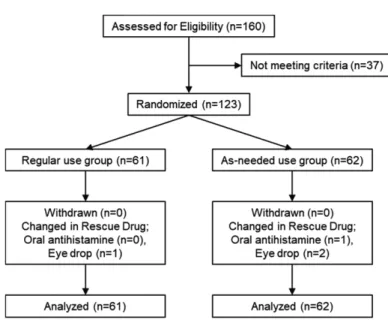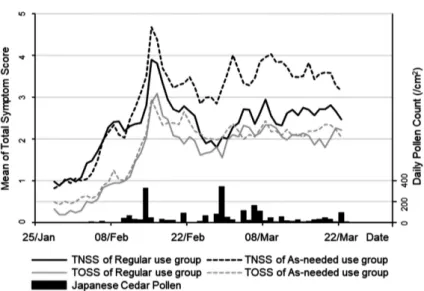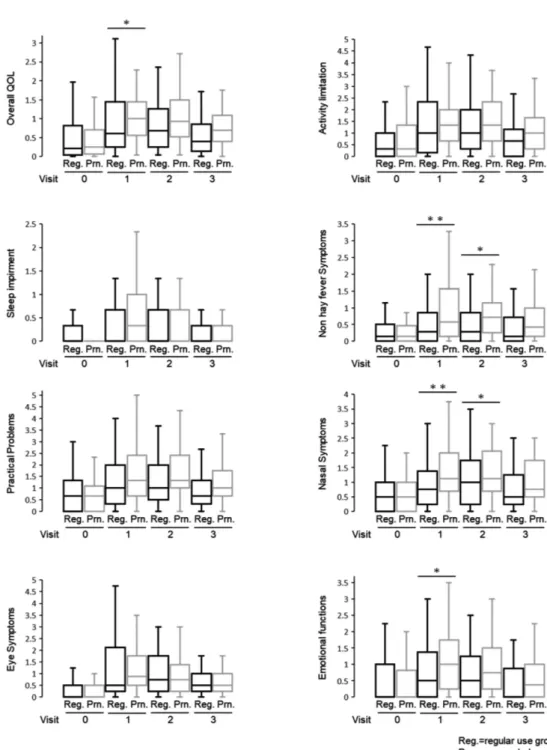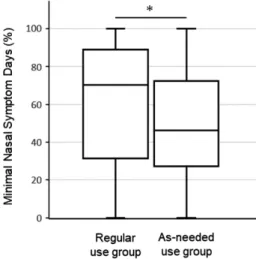INTRODUCTION
Allergic rhinitis (AR) is a global health care problem that affects the daily activity, work pro-ductivity, learning effi ciency, and sleep quality of patients of all ages1). In Japan, a nationwide
epi-demiological survey was conducted in 1998 and 2008. The prevalence of AR has increased over
the past decade. In particular, the prevalence of JCP was 28.8%, higher than those of other types of AR in 2008. Recent data showed that 40% of adults and 45% of children in developed coun-tries suffer from AR2). A survey of patients with
JCP was conducted by the Tokyo Metropolitan Government in 2016. The estimated prevalence of JCP was 48.8%.
In Japan, a large number of patients with JCP experience more severe symptoms for longer periods of time compared to those for other pol-len allergies. Between February and April,
Japa-Comparison of Regular and As-needed Use of Mometasone Furoate
Hydrate Nasal Spray for the Treatment of Japanese Cedar Pollinosis
Kaname SAKAMOTO1), Goro TAKAHASHI2), Takaaki YONAGA1), Shota TANAKA1), Tomokazu MATSUOKA1) and Keisuke MASUYAMA1)
1) Department of Otorhinolaryngology and Head and Neck Surgery, Faculty of Medicine, Graduate Faculty of
Interdisciplinary Research, University of Yamanashi, Yamanashi, Japan
2) Yamahoshi ENT clinic, Shizuoka, Japan
Abstract: Background: Intranasal glucocorticosteroids (INSs) are the first-line treat-ment for allergic rhinitis. However, it is not clear whether regular use of INSs during the pollen season is necessary for patients with Japanese cedar pollinosis (JCP). We con-ducted a randomized, open-label, parallel-group study to compare the effi cacy of regu-lar and as-needed use of INSs.
Method: Between January and May 2009, we recruited patients with Japanese cedar pollinosis and divided them into regular and as-needed use groups. Participants were asked to record nasal and ocular symptom scores every day, and after the start of the trial, Rhinoconjunctivitis Quality of Life Questionnaire (RQLQ) scores were evaluated for three different days.
Result: A total of 123 patients joined this trial. Patients in the regular-use group had sig-nifi cantly improved non-hay fever symptom, nasal symptom, and emotional scores than those in the as-needed group during the fi rst half of the season. The number of days with minimal nasal symptoms in the regular-use group was significantly higher than that in the as-needed group during the entire season (P=0.0261).
Conclusion: Continued use of INSs during the pollen season leads to improvement of symptoms of patients with Japanese cedar pollinosis. Guidance on the appropriate use of INSs is necessary.
Key Words: cedar pollinosis, intranasal steroids, regular or as-needed use
Original article
University of Yamanashi, 1110 Shimokato, Chuo City, Yamanashi, Japan
Received February 25, 2019 Accepted April 11, 2019
nese cedar pollen is dispersed in large quantities over long distances and can remain airborne for more than 12 hours1). Furthermore, pollen
from the Japanese cypress, which has cross an-tigen with Japanese cedar, is dispersed in April and May. Therefore, allergic symptoms may last for as long as four months, from February to May. During this period, about ninety percent of those patients are classifi ed as having moderate-to-severe based by nasal symptom scores1).
Be-cause of the severe symptoms and the duration of symptoms, it is necessary to use INSs continu-ously to maximize the treatment effect during the period of cedar pollinosis.
A number of drugs are available for the treat-ment of AR. Most recent guidelines recommend INSs as a fi rst choice in adults and children be-cause of its higher effi cacy and lower incidence of side effects compared to those of other drugs3–5).
While INSs are the most effective remedy, it is important to determine the correct usage to maximize its effi cacy. The onset of action of INSs starts at time points ranging from 3-5 to 36 hours after the initial dosing3). Previous studies
suggested that the continuous use of INSs was more effective than as-needed use3,4). However,
in previous research, a number of AR patients failed to use INSs continuously, which contrib-uted to unsatisfactory treatment outcomes6,7).
Mometasone furoate nasal spray (MFNS) is an effective and convenient drug to treat sea-sonal and perennial AR in both adults and chil-dren8–10). The continuous use of beclomethasone
dipropionate and fl uticasone propionate nasal sprays were shown to be better than as-needed use for the treatment of AR11,12). However, other
reports suggested the effi cacy of fl uticasone pro-pionate nasal spray in the treatment of seasonal AR, even when used on an as-needed basis13,14).
It remains unclear the effectiveness of continu-ous or as-needed use of INSs for JCP, which has
more severe symptoms and longer duration than those of other hay fevers. We hypothesized that the continuous use of INSs for JCP would be more effective than as-needed use. The pur-pose of this study was to compare the effects of as-needed use of MFNS with those of continuous use on the quality of life (QOL) in the treatment of patients with JCP.
METHODS
Trial design
This randomized, open-label, parallel-group study was conducted at two medical hospitals (University of Yamanashi Hospital and Fu-jiyoshida Municipal Medical Center) in Yama-nashi prefecture, Japan, from January 17 to March 28, 2009. The participants were random-ly assigned in a 1:1 ratio to regular or as-needed groups based on MFNS use. This trial was regis-tered with University of Yamanashi Hospital and was approved by the ethics committee at each participating institution.
Participants
The participants were recruited at the two medical hospitals from January 17 to 31 by ad-vertising the clinical trial in a local newspaper and by sending notices of the trial to patients with JCP who had previously visited these hos-pitals. The inclusion criteria were as follows: (1) age, ≧16 years; (2) history of JCP in previous pollen seasons; (3) positive skin test for Japanese cedar pollen or Japanese cedar pollen-specifi c immunoglobulin E (IgE) based on a radioal-lergosorbent test (RAST) score ≧2. Written in-formed consent was obtained from all partici-pants in this trial.
Patients were excluded if they (1) had used immunosuppressant or systemic corticosteroids within 6 months before recruitment; (2) had
used antibiotics, antihistamines, antileukotrienes, or corticosteroids or intranasally administered antihistamines or corticosteroids within 2 weeks before recruitment; (3) were in the build-up phase of immunotherapy for Japanese cedar pollen; (4) had excessive nasal polyps, sinusitis, or nasal septum deviation that infl uenced the nasal symptoms; (5) had pharyngitis, laryngitis, respiratory tract infection, or asthma; (6) had se-vere heart, hepatic, kidney, or hemal disease; (6) had a history of hypersensitivity to mometasone furoate, loratadine, or sodium cromoglycate; (7) had taken erythromycin or cimetidine at the beginning of the trial; or (8) were lactating or pregnant.
Patients who fulfi lled the eligibility criteria were provided a daily diary to record baseline data on nasal and ocular symptoms for at least 7 days.
Visit 0 (baseline) occurred in the fi rst week of February. The participants visited the hos-pital otorhinolaryngology department with their symptom diaries and were assessed using the Japanese version of the RQLQ. After col-lecting their diaries and RQLQ responses, the participants were re-confi rmed to meet the eligi-bility criteria and randomly assigned to the two groups. They were provided another daily diary to record their nasal and ocular symptoms, drug usage, and any adverse events during the trial. The participants returned in the third week of February (visit 1), the second week of March (visit 2), and the last week of March (visit 3).
Intervention
Regular-use group: Two puffs of mometa-sone furoate (50 µg) per nostril once daily (total 200 µg per day) administered from the begin-ning of the nasal symptoms of pollinosis.
As-needed use group: Two puffs of mometa-sone furoate (50 µg) per nostril once daily when
required to relieve nasal symptoms of pollinosis. Sodium cromoglycate (2%) eye drops were used on an as-needed basis to alleviate ocular symptoms in both groups. One loratadine tablet (10 mg) was taken up to once a day as a rescue medicine.
Outcomes
Participants recorded the severity of four nasal symptoms (rhinorrhea, nasal obstruc-tion, sneezing, and itchy nose) and three ocular symptoms (tearing, redness, and itchy eyes) in their daily diary based on a four-point scale, as follows: 0, no evident symptom; 1, slight symp-tom that is not bothersome; 2, defi nite sympsymp-tom that is bothersome but tolerable; 3, severe symp-tom that is hard to tolerate. The participants also completed an RQLQ at every hospital visit. The primary outcome was the overall RQLQ score during the trial. The secondary outcomes were the seven domain scores of the RQLQ and the number of minimal nasal symptom days (MNSD) during the trial. MSND was defi ned as a day with a total score of ≦2 for four nasal symptom scores.
Statistical analysis
We used STATA 12 for statistical analysis. Analysis of the baseline characteristics followed the intention-to-treat principle. Wilcoxon rank-sum tests were used for comparisons between the two groups of MNSD. Statistical analysis of least-square means (LSM) with 95% confi dence intervals (CI) was conducted using a repeated measurement ANCOVA with the baseline QOL score as a covariate.
RESULTS
Of 160 people who participated in the brief-ing session, 123 fulfi lled the inclusion criteria.
They were randomly assigned to the regular-use (n=61) and as-needed use (n=62) groups. No trial dropouts were observed in either group (Figure 1). Clinical features at baseline (Visit 0) did not differ signifi cantly between the two groups (Table 1). Cedar pollen grains were col-lected and measured using a Durham sampler
daily from January 1, 2009, at the University of Yamanashi Hospital. Cedar pollen was detected from February 5. The total pollen count for the season was 2,518/cm2. The average of total nasal
symptom score (TNSS) and total ocular symp-tom score (TOSS) are shown in the graph, to-gether with the spread of Japanese pollen. In Figure 1. Schematic summary of the fl ow of participants in the trial.
The 123 participants were randomly divided into two groups. Drop-outs from the trial were not observed in either group.
both groups the symptom scores were correlat-ed with the amount of scattering of ccorrelat-edar pollen. There were no signifi cant differences between
regular-use group and as-needed group in TNSS and TOSS (Figure 2). In Figure 3 and Ta-ble 2, the LSM with 95%CI showed a difference Figure 2. Mean total symptom score and daily pollen count.
Cedar pollen grains were collected and measured daily using a Duhram sampler from January 1, 2009 at the University of Yamanashi Hospital. Cedar pollen was counted from February 5 at University of Yamanashi Hospital. The total pollen count for the season was 2,518 per square centimeter. The total symptom score was calculated from patients’ daily diaries. TNSS: total nasal symptom score; TOSS: total ocular symptom score.
Table 2. Differences in scores of the overall QOL and seven QOL domains of the RQLQ between the two groups at each visit
Note: The coeffi cient of ‘living alone’ could not be analysed for male data.
Abbreviation: IADL, instrumental activities of daily living; CI, confi dence interval; Ref, reference category.
Figure 3. Box and whisker plots of overall QOL scores.
The vertical bars indicate the range from lower to upper adjacent values. The horizontal boundaries of the boxes represent the fi rst and third quartiles. The horizontal bar in the boxes indicates the medians. LMS with 95% CI was generated using a repeated measure-ment ANCOVA model. (*P <0.05; **P<0.01) Reg: regular-use group; Prn: as-needed use group.
in QOL score between the 2 groups. In the pri-mary outcome, the overall QOL score at visit 1 was signifi cantly lower in the regular-use group
than that in the as-needed use group (p=0.037). The overall QOL scores at visits 2 and 3 did not differ signifi cantly between the two groups. In the secondary outcome, statistically signifi cant differences were found for non-hay fever symp-toms, nasal sympsymp-toms, and emotional aspects at some visits. However, in other QOL domains signifi cant differences were not found (Figure 3 and Table 2). The percentage of MNSD which indicates a day with few symptoms of hay fe-ver during the trial was statistically signifi cantly higher in the regular-use group than that in the as-needed use group (P=0.0261) (Figure 4). The dosage of loratadine tablets and cromoglycate eye drops which were used as rescue medicines were correlated with the amount of scattering of cedar pollem. Amounts of using loratadine tab-lets and cromoglycate eye drops were similar in both groups (Figure 5).
Nasal bleeding was the most frequently re-ported adverse effect experienced by 6 (9.8%) of the 61 participants in the regular-use group Figure 4. Percentage of MNSD during the trial.
MNSD was defi ned as a day with a total score of ≦2 for all four nasal symptom scores. The difference between the two groups was analyzed by Wilcoxon rank-sum test. (*P=0.0261)
Figure 5. Percentages of participants using medications during the trial.
The drug dosages of loratadine tablets and cromoglicate eye drops are similar in both groups.
and one (1.6%) of the 62 participants in the as-needed group. No adverse effects leading to dis-continuation of the intervention were observed.
DISCUSSION
Many people experience AR worldwide, lead-ing to declines in QOL. INSs are reported to be the most effective treatment for AR and are widely recommended as a fi rst-line drug1,3–5). In
order to use INSs effectively, it is necessary to use them continuously; however, adherence to INSs use is lower adherence than that for oral chemi-cal mediator receptor antagonists6,15). In
addi-tion, JCP has a long disease duration and high severity. Therefore, while more effective treat-ment is required, the differences in therapeutic effect for JCP between the continuous and as-needed use of INSs have not been verifi ed in Ja-pan. Therefore, this trial was conducted to assess the effectiveness of the continued use of INSs for cedar pollen allergy and to improve the INSs ad-herence by comparing the effects of continuous and as-needed use.
A previous study compared the therapeutic effects of continuous-use and as-needed use be-clomethasone for AR, in which continuous use showed a superior therapeutic effect11,12).
How-ever, another comparative test of the therapeutic effect of a placebo and as-needed fl uticasone13,14)
use for AR suggested that the QOL was better in the as-needed group than that for a placebo. Although we used mometasone furoate in the present study, to our knowledge, no studies have used MFNS to assess the treatment effects of as-needed use for AR. In our study, the nasal symptom score of the RQLQ was signifi cantly lower in the continuous use group at visits 1 and 2. MNSD is defi ned as days with nasal symptom scores of 2 or less and the ratios of MNSD are often compared to examine the drug effect on
AR. In addition, the percentage of MNSD was signifi cantly higher in the continued-use group than that in the as-needed use group. Several days are required to reach the maximum thera-peutic effect of INSs; therefore nasal symptoms were signifi cantly suppressed in the continuous use group3).
Among patients with seasonal AR, not only nasal symptoms but also the general QOL are more improved if INSs are used continuous-ly8,16). In our study, the total QOL score in the
regular-use group was signifi cantly higher than that in the as-needed group at visit 1. In term of nasal symptoms, non-hay fever symptoms and emotions, the QOL of the regular-use group was signifi cantly higher in visit 1. However, there was no signifi cant difference in any of the QOL scores in subsequent visits. The total spread of cedar pollen in 2009, when we conducted re-search, was 2,518/cm2, which was higher than
the yearly average17,18). Therefore, the symptoms
of JCP, which tended to be more severe, became stronger in the second half of the season. when pollen exposure increased, and symptoms other than nasal symptoms could not be suppressed with INSs alone. In addition, even in the regu-lar-use group, there were days in which the par-ticipants forget to use INSs, one of the reasons to explain why the INSs usage rate was not 100%. Nosebleeds are the most frequent side effect of INSs and were experienced by seven people in the present trial. However, the bleeds were mild enough that use was not discontinued. Systemic side effects like those for antihistamine do not occur; thus, INSs can be safely used for long pe-riods of time19).
The causes of reduced compliance to treat-ments for AR are various. However, most pa-tients did not use drugs because they had no symptoms. It certainly seems effi cient to use medicines only when symptoms are present6).
In addition, the spread of JCP is sustained and long-term and may be larger than expected depending on the year20). JCP-induced
aller-gic infl ammation in the nasal mucosa even in asymptomatic patients. Even without symptoms, inhalation of the antigen is serious. In order to suppress symptoms throughout the season, it is important to continue to use medications even when there are no symptoms. Continuous use of treatments, regardless of the presence or ab-sence of symptoms, suppresses infl ammation throughout the pollen season and improves symptoms.
Previous studies showed that as-needed use is effective for AR. However, these studies were in comparison to placebos13,14). In our study,
the QOL in the continuous use group was im-proved compared to that in the as-needed use group. However, the normal-use group had bet-ter QOL scores in some respects as well as more MNSD. Therefore, for better control, continued use of INSs enhances the treatment effect and suppresses symptoms. Based on our fi ndings, we not only prescribe INSs but also explain to patients the necessity and effectiveness of con-tinued use, the nature of JCP, and try to increase treatment compliance21,22).
REFERENCES
1) Yamada T, Saito H, Fujieda S: Present state of Japanese cedar pollinosis: The national affl ic-tion. American Academy of Allergy, Asthma & Immunology, 133: 632–639, 2014.
2) Penagos M, Compalati E, Tarantini F, Baena-Cagnani CE, Passalacqua G, Canonica GW: Ef-fi cacy of mometasone furoate nasal spray in the treatment of allergic rhinitis. Meta-analysis of randomized, double-blind, placebo-controlled, clinical trials. Allergy, 63: 1280–1291, 2008. 3) Seidman MD, Gurgel RK, Lin SY, Schwartz SR,
Baroody FM, Bonner JR, et al.: Clinical Practice Guideline: Allergic Rhinitis. American Academy of Otolaryngology-Head and Neck Surgery, 152(1S): S1–S43, 2015.
4) Brozek JL, Bousquet J, Baena-Cagnani CE, Bonini S, Canonica GW, Casale TB, et al.: Al-lergic Rhinitis and its Impact on Asthma (ARIA) 2010 Revision. ALLERGIC RHINITIS AND ITS IMPACT ON ASTHMA GUIDELINES: V. 9/8/2010, 2010.
5) Okubo K, Kurono Y, Ichimura K, Enomoto T, Okamoto Y, Kawauchi H, et al.: Japanese guide-lines for allergic rhinitis 2017. Allergology Inter-national, 66: 205–219, 2017.
6) Loh CY, Chao SS, Chan YH, Wang DY: A clinical survey on compliance in the treatment of rhini-tis using nasal steroids. Allergy, 59: 1168–1172, 2004.
7) Yonezaki M, Akiyama K, Karaki M, Goto R, Inamoto R, Samukawa Y, et al.: Preference evaluation and perceived sensory comparison of fl uticasone furoate and mometasone furoate intranasal sprays in allergic rhinitis. Auris Nasus Larynx, 43: 292–297, 2016.
8) Makihara S, Okano M, Fujieda T, Kimura M, Higaki T, Haruna T, et al.: Early Interventional Treatment with Intranasal Mometasone Furoate in Japanese Cedar/Cypress Pollinosis: A Rand-omized Placebo-Controlled Trial. Allergology international, 61: 295–304, 2012.
9) Graft D, Aaronson D, Chervinsky P, Kaiser H, Mekamed J, Pedinoff A, et al.: A placebo- and active-controlled randomized trial of prophy-lactic treatment of seasonal allergic rhinitis with mometasone furoate aqueous nasal spray. Jour-nal of Allergy and Clinical Immunology, 98: 724–731, 1996.
10) Bielory L, Chun Y, Bielory BP, Canonica GW: Impact of mometasone furoate nasal spray on individual ocular symptoms of allergic rhinitis: a meta-analysis. Allergy, 66: 686–693, 2011. 11) Juniper EF, Guyatt GH, Byrne PM, Viveiros
M: Aqueous beclomethasone diproprionate na-sal spray: Regular versus “as required” use in the treatment of seasonal allergic rhinitis. The Journal of Allergy and Clinical Immunology, 86: 380–386, 1990.
12) Juniper EF, Guyatt GH, Archer B, Ferrie PJ: Aqueous beclomethasone dipropionate in the treatment of ragweed pollen-induced rhinitis: further exploration of “as needed” use. The Journal of Allergy and Clinical Immunology, 92: 66–72, 1993.
13) Jen A, Baroody F, Tineo M, Haney L, Blair C, Naclerio R: As-needed use of fl uticasone propi-onate nasal spray reduces symptoms of seasonal allergic rhinitis. Journal of Allergy and Clinical Immunology, 105: 732–738, 2000.
14) Dykewicz MS, Kaiser HB, Nathan RA, Goode-Sellers A, Cook CK, Witham LA, et al.: Flutica-sone propionate aqueous nasal spray improves nasal symptoms of seasonal allergic rhinitis when used as needed (prn). Annals of Allergy, Asthma and Immunology, 91: 44–48, 2003. 15) Matsubara A, Futai K, Shirasaki T, Nagaki T,
Ikeno K, Tanita J, et al.: Medication compliance of oral anti-allergic drugs to perennial allergic rhinitis. jibi to rinsho, 55: 39–45, 2009. (in Japa-nese)
16) Rodrigo GJ, Neffen H: Effi cacy of fl uticasone furoate nasal spray vs. placebo for the treatment of ocular and nasal symptoms of allergic rhinitis: a systematic review. Clinical & Experimental Al-lergy, 41: 160–170, 2011.
17) Isono M, Oto T, Ozawa H, Shimada K, Fujimori I, Horiuchi H, et al.: The situation of Yumanashi prefecture’s 2009 cedar and cypress pollen dis-persion. ENT Report Yamanashi, 27: 49–53, 2009.
18) Kishikawa R, Kotoh E, Oshikawa, Soh N, Shi-moda T, Saito A, et al.: Longitudinal monitoring
of tree airborne pollen in Japan ̶ regional dis-tribution and annual change of important aller-gic tree pollen ̶. Japanese Journal of Allergol-ogy, 66: 97–111, 2017. (in Japanese)
19) Rosenblut A, Bardin PG, Muller B, Faris MA, Wu WW, Caldwell MF, et al.: Long-term safety of fl uticasone furoate nasal spray in adults and adolescents with perennial allergic rhinitis. Al-lergy, 62: 1071–1077, 2007.
20) Prediction study work report on pollinosis in 2016. Weather Service Co., Ltd. 2017 (in Japa-nese)
21) Skadding GK, Richrds DH, Price MJ: Patient and physician perspectives on the impact and management of perennial and seasonal allergic rhinitis. Clinical Otolaryngology & Allied Sci-ences, 25: 551–557, 2000.
22) Gani F, Pozzi E, Crivellaro MA, Senna G, Landi M, Lombardi C, et al.: The role of patient train-ing in the management of seasonal rhinitis and asthma: clinical implications. Allergy, 56: 65–68, 2001.



